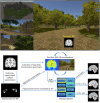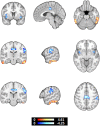Earliest amyloid and tau deposition modulate the influence of limbic networks during closed-loop hippocampal downregulation
- PMID: 32091109
- PMCID: PMC7089658
- DOI: 10.1093/brain/awaa011
Earliest amyloid and tau deposition modulate the influence of limbic networks during closed-loop hippocampal downregulation
Abstract
Research into hippocampal self-regulation abilities may help determine the clinical significance of hippocampal hyperactivity throughout the pathophysiological continuum of Alzheimer's disease. In this study, we aimed to identify the effects of amyloid-β peptide 42 (amyloid-β42) and phosphorylated tau on the patterns of functional connectomics involved in hippocampal downregulation. We identified 48 cognitively unimpaired participants (22 with elevated CSF amyloid-β peptide 42 levels, 15 with elevated CSF phosphorylated tau levels, mean age of 62.705 ± 4.628 years), from the population-based 'Alzheimer's and Families' study, with baseline MRI, CSF biomarkers, APOE genotyping and neuropsychological evaluation. We developed a closed-loop, real-time functional MRI neurofeedback task with virtual reality and tailored it for training downregulation of hippocampal subfield cornu ammonis 1 (CA1). Neurofeedback performance score, cognitive reserve score, hippocampal volume, number of apolipoprotein ε4 alleles and sex were controlled for as confounds in all cross-sectional analyses. First, using voxel-wise multiple regression analysis and controlling for CSF biomarkers, we identified the effect of healthy ageing on eigenvector centrality, a measure of each voxel's overall influence based on iterative whole-brain connectomics, during hippocampal CA1 downregulation. Then, controlling for age, we identified the effects of abnormal CSF amyloid-β42 and phosphorylated tau levels on eigenvector centrality during hippocampal CA1 downregulation. Across subjects, our main findings during hippocampal downregulation were: (i) in the absence of abnormal biomarkers, age correlated with eigenvector centrality negatively in the insula and midcingulate cortex, and positively in the inferior temporal gyrus; (ii) abnormal CSF amyloid-β42 (<1098) correlated negatively with eigenvector centrality in the anterior cingulate cortex and primary motor cortex; and (iii) abnormal CSF phosphorylated tau levels (>19.2) correlated with eigenvector centrality positively in the ventral striatum, anterior cingulate and somatosensory cortex, and negatively in the precuneus and orbitofrontal cortex. During resting state functional MRI, similar eigenvector centrality patterns in the cingulate had previously been associated to CSF biomarkers in mild cognitive impairment and dementia patients. Using the developed closed-loop paradigm, we observed such patterns, which are characteristic of advanced disease stages, during a much earlier presymptomatic phase. In the absence of CSF biomarkers, our non-invasive, interactive, adaptive and gamified neuroimaging procedure may provide important information for clinical prognosis and monitoring of therapeutic efficacy. We have released the developed paradigm and analysis pipeline as open-source software to facilitate replication studies.
Keywords: CA1; ECM; amyloid-β42; p-tau; rt-fMRI.
© The Author(s) (2020). Published by Oxford University Press on behalf of the Guarantors of Brain.
Figures




Comment in
-
Virtual reality and real-time neurofeedback functional MRI: a breakthrough in foreseeing Alzheimer's disease?Brain. 2020 Mar 1;143(3):722-726. doi: 10.1093/brain/awaa038. Brain. 2020. PMID: 32203574 No abstract available.
References
-
- Adriaanse SM, Wink AM, Tijms BM, Ossenkoppele R, Verfaillie SCJ, Lammertsma AA, et al.The association of glucose metabolism and eigenvector centrality in Alzheimer’s disease. Brain Connect 2016; 6: 1–8. - PubMed
-
- Albada VS, Robinson PA. Transformation of arbitrary distributions to the normal distribution with application to EEG test–retest reliability. J Neurosci Methods 2007; 161: 205–11. - PubMed
-
- Alnæs D, Sneve MH, Richard G, Skåtun KC, Kaufmann T, Nordvik JE, et al.Functional connectivity indicates differential roles for the intraparietal sulcus and the superior parietal lobule in multiple object tracking. Neuroimage 2015; 123: 129–37. - PubMed
-
- Antonenko D, Nierhaus T, Meinzer M, Prehn K, Thielscher A, Ittermann B, et al.Age-dependent effects of brain stimulation on network centrality. Neuroimage 2018; 176: 71–82. - PubMed
Publication types
MeSH terms
Substances
LinkOut - more resources
Full Text Sources
Medical
Miscellaneous

